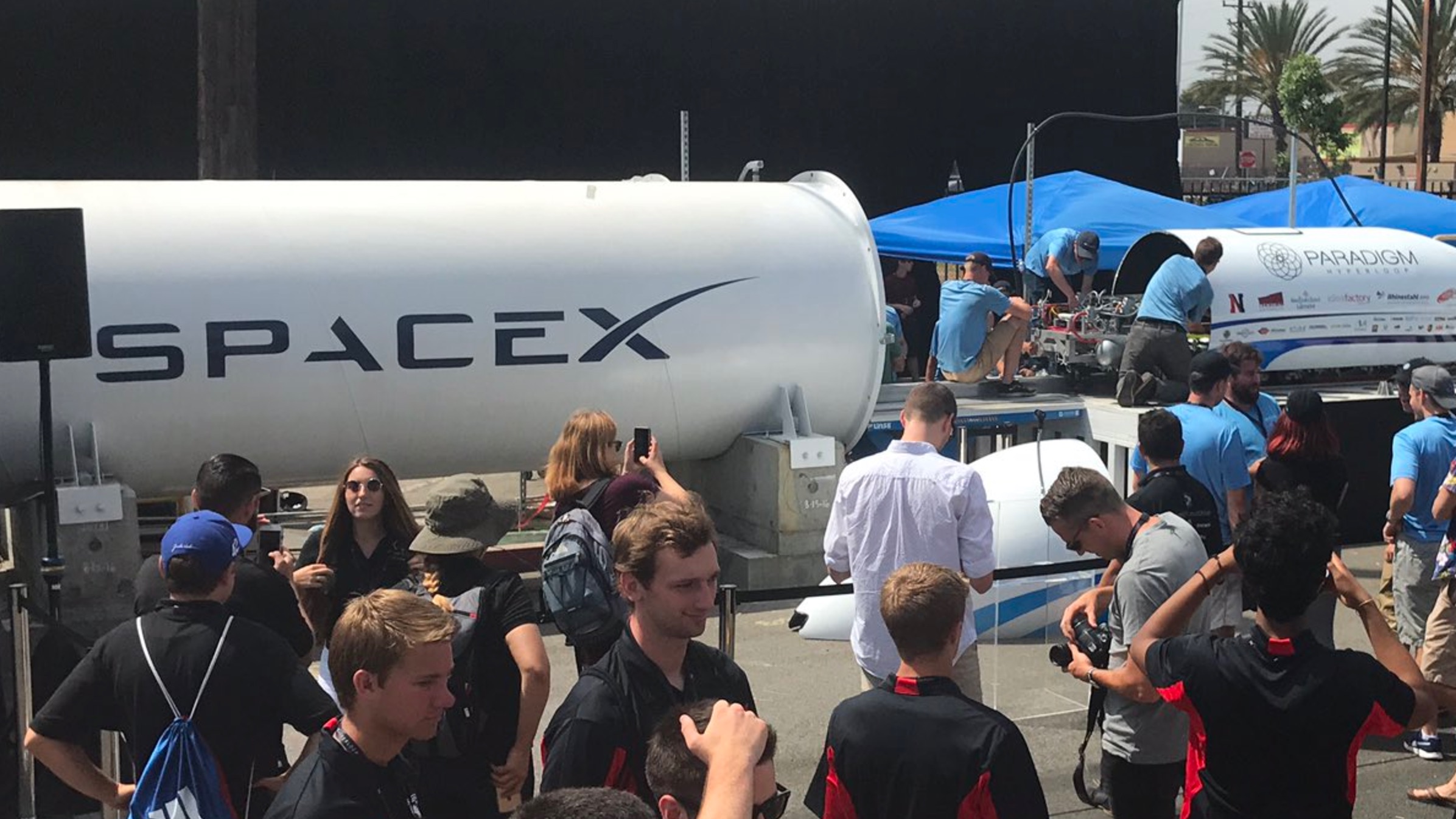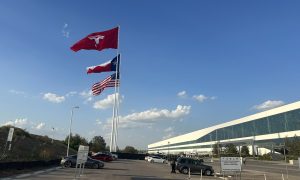

News
SpaceX Hyperloop Competition: Top 3 teams duke it out for fastest pod
Hawthorne councilmembers, members of the California Assembly, and Hawthorne Mayor Alex Vargas were in attendance at the headquarters of SpaceX and The Boring Company for their jointly-hosted Hyperloop Competition 2.
The second such Hyperloop competition sponsored by Elon Musk, the eight months that separated them were filled to the brim with press coverage of The Boring Company (TBC), which has begun to seriously develop an experimental tunnel beneath a central street in Hawthorne, CA. Most intriguingly, TBC publicly acknowledged that it is now pursuing the development of its own form of Hyperloop technology, originally developed and released as a white paper by Elon Musk, albeit with tunnels rather than above-ground vacuum tube constructs.
Update: Watch Elon Musk award this team for having the fastest Hyperloop pod at 202 mph
The second competition was focused on one goal, above all others: top speed. The final three teams chosen for testing in SpaceX’s mile-long vacuum tube were as international as ever. Paradigm Hyperloop, a continuation of the Openloop team from Competition 1, is composed of 26 students from the northeastern U.S. and Canada, designed a pod that made use of air bearings to levitate and was intended to travel as fast as 200 mph through SpaceX’s test track. While not yet officially confirmed, a livestream suggested that their pod reached a maximum speed of approximately 100 km/h or 62 mph. While nowhere near its purported top speed, a member of Paradigm Hyperloop said that the team’s pod “levitated perfectly” and that the test generally went great. Their pod was one of the largest, weighing in at almost a metric ton.
SwissLoop, a team of 40 or so students from Swiss university ETH Zurich, developed a pod that levitated with permanent magnets and was propelled by compressed air, sort of like a rocket. SwissLoop’s SpaceX adviser, a mechanical engineer focused on reusing Falcon 9s on normal days, praised the group’s engineering and construction of the pod during a livestream on Facebook. SwissLoop experienced some technical difficulties while Musk waiting to provide the countdown in Swiss German, and he quipped about connectivity issues that the team was having with their pod. Musk later announced that due to those technical difficulties, SwissLoop’s pod would be removed for troubleshooting and WARR Hyperloop would conduct the second live test.
Pod problem. Developing futuristic transport isn't quick. #Hyperloop pic.twitter.com/QJAngYvCbP
— Jack Stewart (@stewart_jack) August 27, 2017
WARR Hyperloop, the victors of the first Competition, prepared their Pod ii to be tested on Sunday afternoon. One of the smallest pods at only 190 lb, the vehicle was intended to have a top speed of approximately 225 mph – a speed it was reported to be capable of reaching in 12 seconds. Designed by students from the Technical University of Munich, the pod was propelled with a 50 kW electric motor connected to polyurethane wheels. While the method of levitation was not specified, it is understood to be a system of permanent magnets similar to SwissLoop’s implementation. WARR is a German organization and stands for Scientific Workgroup for Rocketry and Spaceflight in English.
Elon Musk somewhat controversially revealed that The Boring Company had received “verbal approval” for an underground Hyperloop between Washington D.C. and New York City, appearing to acknowledge some form of back-room deal with the federal government. He later clarified in a series of tweets and replies that the approval was extremely preliminary and unofficial and that The Boring Company was hard at work beginning to form relationships with the numerous municipalities that would be involved along the proposed route. The several Hyperloop-related companies that formed following Musk’s white paper have been reluctant to make room for a new, Musk-headed competitor in the ring, but The Boring Company is aggressively pushing ahead with their demonstration tunnel in Hawthorne, CA and has successfully applied for the initial permits that will be required.
Mirroring Elon’s typically positive opinion of competition, he bid Hyperloop One and all other companies trying to revolutionize transportation the best of luck during Competition 2. Competition 2 is guaranteed to provide SpaceX and The Boring Company an inside glance at some of the best emerging engineering talent. Hosting the competition is quite possibly the most suave and effective method of recruitment one can readily imagine, with all promising teams generally being given private tours of both The Boring Company and SpaceX facilities.
I hope they and any others trying to advance transport technology succeed
— Elon Musk (@elonmusk) August 27, 2017
Meanwhile, stay tuned for the two max speed pod tests to come later this afternoon. There is no live coverage from SpaceX itself, but SwissLoop has been kind enough to livestream several of the main events on their Facebook page. You can also follow a live Facebook stream here. Follow along live there and check back at Teslarati for coverage of the events!
News
Tesla begins Robotaxi certification push in Arizona: report
Tesla seems serious about expanding its Robotaxi service to several states in the coming months.

Tesla has initiated discussions with Arizona transportation regulators to certify its driverless Robotaxi service in the state, as per a recent report from Bloomberg News. The move follows Tesla’s launch of its Robotaxi pilot program in Austin, Texas, as well as CEO Elon Musk’s recent comments about the service’s expansion in the Bay Area.
The Arizona Department of Transportation confirmed to Bloomberg that Tesla has reached out to begin the certification process for autonomous ride-sharing operations in the state. While details remain limited, the outreach suggests that Tesla is serious about expanding its driverless Robotaxi service to several territories in the coming months.
The Arizona development comes as Tesla prepares to expand its service area in Austin this weekend, as per CEO Elon Musk in a post on X. Musk also stated that Tesla is targeting the San Francisco Bay Area as its next major market, with a potential launch “in a month or two,” pending regulatory approvals.
Tesla first launched its autonomous ride-hailing program on June 22 in Austin with a small fleet of Model Y vehicles, accompanied by a Tesla employee in the passenger seat to monitor safety. While still classified as a test, Musk has said the program will expand to about 1,000 vehicles in the coming months. Tesla will later upgrade its Robotaxi fleet with the Cyercab, a two-seater that is designed without a steering wheel.
Sightings of Cybercab castings around the Giga Texas complex suggests that Tesla may be ramping the initial trial production of the self-driving two-seater. Tesla, for its part, has noted in the past that volume production of the Cybercab is expected to start sometime next year.
In California, Tesla has already applied for a transportation charter-party carrier permit from the state’s Public Utilities Commission. The company is reportedly taking a phased approach to operating in California, with the Robotaxi service starting with pre-arranged rides for employees in vehicles with safety drivers.
News
Tesla sets November 6 date for 2025 Annual Shareholder Meeting
The automaker announced the date on Thursday in a Form 8-K.

Tesla has scheduled its 2025 annual shareholder meeting for November 6, addressing investor concerns that the company was nearing a legal deadline to hold the event.
The automaker announced the date on Thursday in a Form 8-K submitted to the United States Securities and Exchange Commission (SEC). The company also listed a new proposal submission deadline of July 31 for items to be included in the proxy statement.
Tesla’s announcement followed calls from a group of 27 shareholders, including the leaders of large public pension funds, which urged Tesla’s board to formally set the meeting date, as noted in a report from The Wall Street Journal.
The group noted that under Texas law, where Tesla is now incorporated, companies must hold annual meetings within 13 months of the last one if requested by shareholders. Tesla’s previous annual shareholder meeting was held on June 13, 2024, which placed the July 13 deadline in focus.
Tesla originally stated in its 2024 annual report that it would file its proxy statement by the end of April. However, an amended filing on April 30 indicated that the Board of Directors had not yet finalized a meeting date, at least at the time.
The April filing also confirmed that Tesla’s board had formed a special committee to evaluate certain matters related to CEO Elon Musk’s compensation plan. Musk’s CEO performance award remains at the center of a lengthy legal dispute in Delaware, Tesla’s former state of incorporation.
Due to the aftermath of Musk’s legal dispute about his compensation plan in Delaware, he has not been paid for his work at Tesla for several years. Musk, for his part, has noted that he is more concerned about his voting stake in Tesla than his actual salary.
At last year’s annual meeting, TSLA shareholders voted to reapprove Elon Musk’s compensation plan and ratified Tesla’s decision to relocate its legal domicile from Delaware to Texas.
Elon Musk
Grok coming to Tesla vehicles next week “at the latest:” Elon Musk
Grok’s rollout to Tesla vehicles is expected to begin next week at the latest.

Elon Musk announced on Thursday that Grok, the large language model developed by his startup xAI, will soon be available in Tesla vehicles. Grok’s rollout to Tesla vehicles is expected to begin next week at the latest, further deepening the ties between the two Elon Musk-led companies.
Tesla–xAI synergy
Musk confirmed the news on X shortly after livestreaming the release of Grok 4, xAI’s latest large language model. “Grok is coming to Tesla vehicles very soon. Next week at the latest,” Musk wrote in a post on social media platform X.
During the livestream, Musk and several members of the xAI team highlighted several upgrades to Grok 4’s voice capabilities and performance metrics, positioning the LLM as competitive with top-tier models from OpenAI and Google.
The in-vehicle integration of Grok marks a new chapter in Tesla’s AI development. While Tesla has long relied on in-house systems for autonomous driving and energy optimization, Grok’s integration would introduce conversational AI directly into its vehicles’ user experience. This integration could potentially improve customer interaction inside Tesla vehicles.
xAI and Tesla’s collaborative footprint
Grok’s upcoming rollout to Tesla vehicles adds to a growing business relationship between Tesla and xAI. Earlier this year, Tesla disclosed that it generated $198.3 million in revenue from commercial, consulting, and support agreements with xAI, as noted in a report from Bloomberg News. A large portion of that amount, however, came from the sale of Megapack energy storage systems to the artificial intelligence startup.
In July 2023, Musk polled X users about whether Tesla should invest $5 billion in xAI. While no formal investment has been made so far, 68% of poll participants voted yes, and Musk has since stated that the idea would be discussed with Tesla’s board.
-

 Elon Musk1 week ago
Elon Musk1 week agoTesla investors will be shocked by Jim Cramer’s latest assessment
-

 Elon Musk3 days ago
Elon Musk3 days agoElon Musk confirms Grok 4 launch on July 9 with livestream event
-

 Elon Musk18 hours ago
Elon Musk18 hours agoxAI launches Grok 4 with new $300/month SuperGrok Heavy subscription
-

 News7 days ago
News7 days agoTesla Model 3 ranks as the safest new car in Europe for 2025, per Euro NCAP tests
-

 Elon Musk2 weeks ago
Elon Musk2 weeks agoA Tesla just delivered itself to a customer autonomously, Elon Musk confirms
-

 Elon Musk1 week ago
Elon Musk1 week agoxAI’s Memphis data center receives air permit despite community criticism
-

 Elon Musk2 weeks ago
Elon Musk2 weeks agoTesla’s Omead Afshar, known as Elon Musk’s right-hand man, leaves company: reports
-

 News2 weeks ago
News2 weeks agoXiaomi CEO congratulates Tesla on first FSD delivery: “We have to continue learning!”













